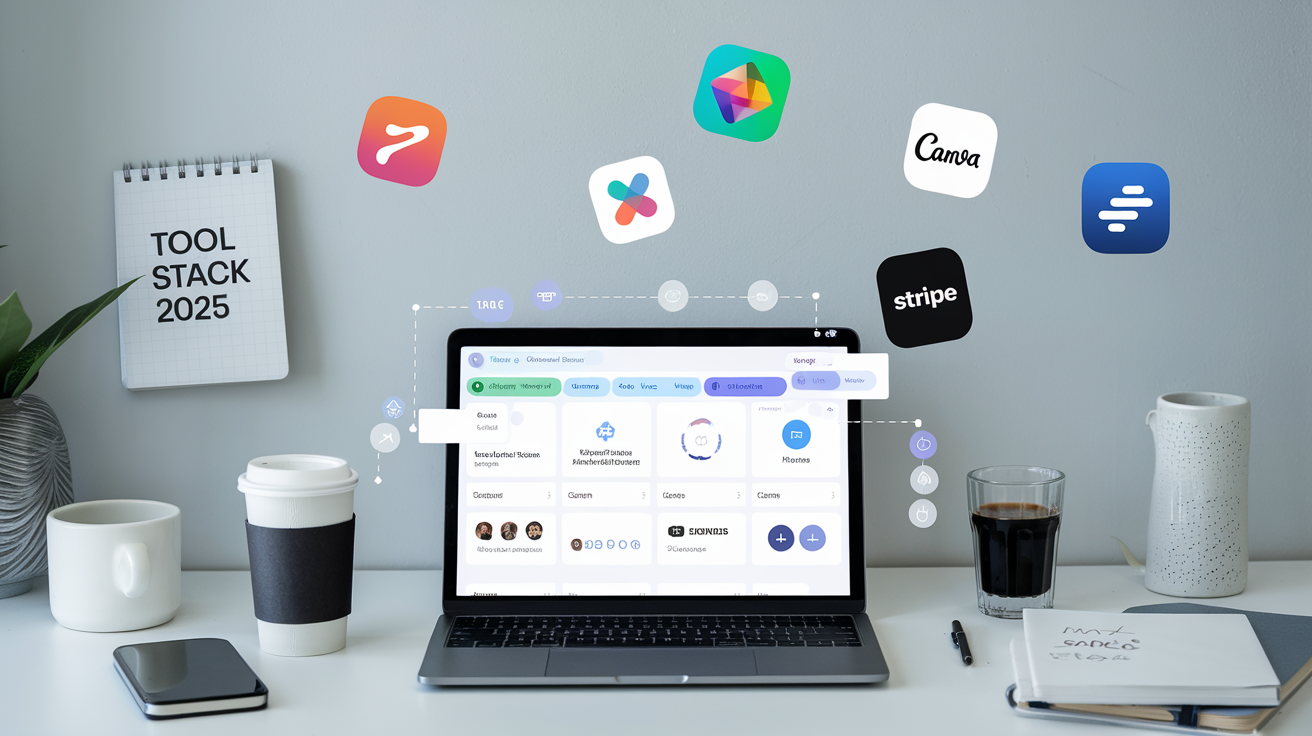How To Make Money Blogging in 2025
Making money blogging in 2025 isn’t just possible—it’s more accessible than ever before. With the right strategic approach, consistent execution, and modern monetization techniques, you can transform your blog from a simple hobby into a thriving six-figure business. This comprehensive guide will walk you through every step of the journey, from initial setup to scaling your income streams.
The blogging landscape has evolved dramatically, with new opportunities emerging alongside traditional methods. Success now depends on understanding your audience deeply, creating exceptional value, and leveraging multiple revenue streams. This isn’t about quick fixes or overnight success—it’s about building a sustainable business that grows consistently over time.
Legal and Compliance Considerations
Proper legal setup protects your blog business and builds trust with readers and partners. These considerations are essential for long-term success and monetization.
Essential Legal Pages
Privacy Policy:
- Required by law in most jurisdictions
- Explain data collection and usage
- Include cookie policy information
- Update regularly as practices change
Terms of Service:
- Protect your intellectual property
- Limit liability for content and recommendations
- Establish user behavior expectations
- Include dispute resolution procedures
Disclaimer:
- Clarify that content is for informational purposes
- Specify that you’re not providing professional advice
- Include affiliate relationship disclosures
- Protect against liability claims
Disclosure Requirements
Affiliate Marketing:
- FTC requires clear disclosure of affiliate relationships
- Use #ad or #affiliate hashtags on social media
- Include disclosure statements in blog posts
- Make disclosures visible and understandable
Sponsored Content:
- Clearly label sponsored posts
- Maintain editorial independence
- Disclose partnerships prominently
- Follow platform-specific guidelines
Intellectual Property
Copyright Protection:
- Register copyrights for valuable content
- Use proper attribution for images and quotes
- Implement DMCA takedown procedures
- Monitor for content theft
Trademark Considerations:
- Check trademark status before using brand names
- Consider trademarking your blog name
- Respect others’ trademark rights
- Use trademark symbols appropriately
International Considerations
GDPR Compliance (European readers):
- Implement cookie consent banners
- Provide data deletion options
- Maintain privacy policy compliance
- Appoint data protection officers if required
Tax Obligations:
- Understand tax implications of different revenue streams
- Keep detailed financial records
- Consider business structure (LLC, corporation)
- Consult tax professionals for complex situations
AI Integration and Automation
In 2025, 80% of bloggers use AI for a variety of tasks, making AI integration essential for competitive blogging. Understanding how to leverage AI tools effectively can dramatically improve your productivity and content quality.
AI Content Creation Tools
Writing and Editing:
- ChatGPT/Claude: Content ideation, outlines, and first drafts
- Jasper: Marketing-focused content generation
- Copy.ai: Sales copy and marketing materials
- Grammarly: Advanced grammar and style checking
- Wordtune: Sentence rewriting and improvement
Content Enhancement:
- Frase: SEO-optimized content creation
- MarketMuse: Content strategy and optimization
- Surfer SEO: AI-powered content optimization
- Clearscope: Content optimization for search intent
AI for Visual Content
Image Generation:
- Midjourney: High-quality artistic images
- DALL-E 3: Versatile image creation
- Canva AI: Quick design generation
- Stable Diffusion: Free, open-source image generation
Video Creation:
- Synthesia: AI avatar videos
- Lumen5: Text-to-video conversion
- Runway ML: Advanced video editing and generation
- Pictory: Blog post to video conversion
AI Automation for Blogging
Social Media Management:
- Buffer AI: Automated social media posts
- Hootsuite Insights: AI-powered social listening
- Lately: AI content repurposing for social media
Email Marketing:
- Mailchimp AI: Automated email sequences
- ConvertKit AI: Personalized email content
- Optimove: Predictive email marketing
SEO and Research:
- Ahrefs AI: Keyword research and content gaps
- SEMrush AI: Competitive analysis and optimization
- BrightEdge: Enterprise AI SEO platform
Best Practices for AI Integration
Quality Control:
- Always fact-check AI-generated content
- Maintain your unique voice and perspective
- Use AI as a starting point, not the final product
- Combine AI efficiency with human creativity
Ethical AI Use:
- Disclose AI assistance when appropriate
- Respect copyright and avoid plagiarism
- Maintain authenticity in your content
- Use AI to enhance, not replace, human insight
Adapting to Google’s AI Overviews
AI Overviews are on the rise: 13.14% of all queries triggered AI Overviews in March 2025, fundamentally changing how content appears in search results. AI search means fewer clicks, more zero-click results, and a shrinking slice of visibility for bloggers.
Understanding the Impact
Traffic Changes:
- With Google AI Mode delivering summarized answers directly in search, users no longer need to click through to individual websites to find what they’re looking for
- Reduced click-through rates for informational content
- Increased importance of branded searches and direct traffic
- Greater emphasis on unique, original content
Content Strategy Adaptations:
- Avoid writing about simple informational topics that could be answered easily by an AI overview
- Focus on complex, nuanced topics requiring expertise
- Provide unique perspectives and original research
- Create content that encourages deeper engagement
Strategies for AI Overview Success
Content Optimization:
- Structured Data: Use schema markup for better understanding
- Featured Snippet Optimization: Format content for easy extraction
- Authority Building: Establish topical expertise and credibility
- Original Research: Conduct studies and surveys for unique data
Beyond Basic Information:
- Personal Experiences: Share unique stories and insights
- Case Studies: Provide detailed real-world examples
- Tutorials: Create step-by-step guides with visuals
- Comparisons: Offer detailed product and service comparisons
Revenue Protection Strategies
Diversify Beyond Ad Revenue:
- Build direct relationships with your audience
- Create premium content and memberships
- Develop email lists for direct communication
- Focus on affiliate marketing and product sales
Brand Building:
- Establish thought leadership in your niche
- Create memorable, searchable brand names
- Build social media presence for direct traffic
- Develop unique methodologies and frameworks
Foundation: Setting Up Your Profitable Blog {#foundation}
Choosing the Right Platform and Hosting
Your platform choice affects everything from customization options to monetization potential. Here’s what you need to know:
WordPress.org (Self-Hosted) – Best for Serious Bloggers
- Complete control and unlimited customization
- Full monetization capabilities
- Professional appearance and functionality
- Cost: $3-15/month for hosting + $15/year for domain
Alternative Platforms:
- Squarespace: Beautiful templates, easier setup ($12-40/month)
- Ghost: Writing-focused, clean interface ($9-79/month)
- Webflow: Advanced design capabilities ($12-36/month)
Essential Technical Setup
Domain and Hosting Considerations:
- Choose a memorable, brandable domain name
- Select reliable hosting (SiteGround, WP Engine, or Bluehost)
- Implement SSL certificate for security
- Set up CDN for faster loading speeds
Must-Have Plugins and Tools:
- SEO: Yoast SEO or RankMath
- Analytics: Google Analytics 4 + Google Search Console
- Email Marketing: ConvertKit or Mailchimp integration
- Security: Wordfence or Sucuri
- Performance: WP Rocket or W3 Total Cache
- Social Sharing: Social Warfare or Grow Social
Professional Design Elements
Your blog’s appearance directly impacts credibility and earning potential:
- Clean, responsive design that works on all devices
- Fast loading times (under 3 seconds)
- Clear navigation and user-friendly structure
- Professional color scheme and typography
- About page that builds trust and authority
- Contact information and legal pages (privacy policy, terms)
Niche Selection and Market Research
High-Profit Niches for 2025
Evergreen High-Value Niches:
- Personal Finance: Credit cards, investing, budgeting, debt management
- Health & Wellness: Fitness, nutrition, mental health, weight loss
- Technology: Software reviews, gadgets, cybersecurity, AI tools
- Business & Entrepreneurship: Marketing, productivity, side hustles
- Home & Garden: Interior design, DIY projects, sustainable living
Emerging Profitable Niches:
- Remote Work: Digital nomad lifestyle, home office setup, virtual tools
- Sustainability: Eco-friendly products, green living, climate solutions
- AI and Automation: Tools, tutorials, industry impacts
- Mental Health: Stress management, mindfulness, therapy resources
- Cryptocurrency: Trading, NFTs, blockchain technology
Market Research Strategies
Audience Research Methods:
- Keyword Research: Use tools like Ahrefs, SEMrush, or Ubersuggest
- Competitor Analysis: Study successful blogs in your niche
- Social Media Listening: Monitor relevant Facebook groups, Reddit communities
- Survey Your Audience: Use Google Forms or Typeform for feedback
- Analytics Deep Dive: Understand your current audience demographics
Validation Techniques:
- Check if people are already paying for solutions in your niche
- Look for active affiliate programs and sponsored content opportunities
- Analyze search volume and competition levels
- Identify gaps in existing content coverage
Niche Positioning Strategy
The Riches Are in the Niches: Instead of “fitness,” consider “fitness for busy professionals over 40” Instead of “cooking,” focus on “quick healthy meals for college students” Instead of “technology,” specialize in “productivity apps for remote workers”
Your Unique Value Proposition:
- What specific problem do you solve?
- What makes your perspective unique?
- What credentials or experience do you bring?
- How do you deliver information differently?
Content Strategy and Creation
Content Planning and Editorial Calendar
Monthly Content Planning:
- Week 1: Educational/How-to content
- Week 2: Product reviews and comparisons
- Week 3: Personal stories and case studies
- Week 4: Industry news and trend analysis
Content Types That Drive Traffic and Sales:
- Long-form guides (3,000+ words)
- Product reviews and comparisons
- Case studies and success stories
- Industry news and trend analysis
- Tool recommendations and tutorials
- Personal experiences and lessons learned
SEO-Optimized Content Creation
Keyword Research Process:
- Start with seed keywords in your niche
- Use tools to find related long-tail keywords
- Analyze search intent behind each keyword
- Check competition levels and ranking difficulty
- Create content clusters around main topics
Content Optimization Checklist:
- Title tags: Include primary keyword, stay under 60 characters
- Meta descriptions: Compelling, keyword-rich, under 160 characters
- Headers: Use H1, H2, H3 structure with keywords
- Internal linking: Connect related posts for better site structure
- Image optimization: Alt text, compressed files, descriptive names
- Featured snippets: Format content to answer common questions
Content Quality Standards
Elements of High-Converting Content:
- Compelling headlines that promise specific benefits
- Strong introductions that hook readers immediately
- Scannable format with subheadings, bullet points, and images
- Actionable advice that readers can implement
- Social proof through testimonials and case studies
- Clear call-to-actions that guide reader behavior
Content Depth and Authority:
- Research thoroughly and cite credible sources
- Include personal experiences and unique insights
- Update content regularly to maintain relevance
- Add multimedia elements (videos, infographics, podcasts)
- Encourage engagement through comments and social shares
Traffic Generation Mastery
Search Engine Optimization (SEO)
Technical SEO Essentials:
- Site speed optimization: Compress images, use caching, minimize code
- Mobile responsiveness: Ensure perfect mobile experience
- URL structure: Clean, descriptive URLs with keywords
- XML sitemaps: Help search engines index your content
- Schema markup: Rich snippets for better search appearance
Content SEO Strategy:
- Topic clusters: Create comprehensive coverage of related topics
- Long-tail keywords: Target specific, less competitive phrases
- User intent matching: Align content with what searchers want
- E-A-T factors: Expertise, Authoritativeness, Trustworthiness
- Local SEO: If applicable, optimize for local searches
Social Media Marketing
Platform-Specific Strategies:
Pinterest (Excellent for Blog Traffic):
- Create vertical pins with text overlay
- Use keyword-rich descriptions
- Pin consistently to relevant boards
- Join group boards in your niche
- Use Pinterest SEO best practices
Instagram:
- Share behind-the-scenes content
- Use Stories to drive traffic
- Create educational carousel posts
- Engage with your community actively
- Use relevant hashtags strategically
Twitter/X:
- Share valuable insights and tips
- Engage in industry conversations
- Use threads for longer content
- Retweet and comment on others’ content
- Share blog posts with compelling snippets
LinkedIn (For B2B Niches):
- Publish native articles
- Engage in professional discussions
- Share industry insights
- Connect with potential collaborators
- Use LinkedIn Groups for networking
Email Marketing for Traffic
List Building Strategies:
- Lead magnets: Free ebooks, checklists, templates, courses
- Content upgrades: Bonus material related to specific posts
- Opt-in forms: Exit-intent popups, inline forms, sidebar widgets
- Webinars: Free training sessions with valuable content
- Exclusive content: Members-only resources and insights
Email Campaign Types:
- Welcome series: Introduce new subscribers to your best content
- Weekly newsletters: Consistent value delivery and traffic driving
- Product launches: Promote your own products and services
- Affiliate promotions: Recommend relevant products and services
- Re-engagement campaigns: Win back inactive subscribers
Paid Traffic Strategies
Google Ads for Bloggers:
- Target long-tail keywords with buyer intent
- Create compelling ad copy that matches search intent
- Use ad extensions for better visibility
- Test different landing pages for conversion
- Monitor and optimize based on performance data
Social Media Advertising:
- Facebook/Instagram Ads: Target specific demographics and interests
- Pinterest Ads: Promote high-performing pins to broader audiences
- YouTube Ads: Video content to drive traffic and subscriptions
- LinkedIn Ads: B2B targeting for professional niches
Monetization Strategies
Affiliate Marketing Mastery
Choosing the Right Affiliate Programs:
- High commission rates: 20-50% recurring or $50+ per sale
- Quality products: Only promote what you genuinely recommend
- Good tracking: Reliable affiliate networks and tracking systems
- Long cookie duration: 30-90 days for better conversion rates
- Promotional materials: Banners, email templates, product information
Top Affiliate Networks and Programs:
- Amazon Associates: Low commission but high conversion rates
- ShareASale: Diverse range of merchants and products
- CJ Affiliate: Premium brands and higher commissions
- ClickBank: Digital products with high commission rates
- Individual programs: Direct partnerships with companies
Affiliate Marketing Best Practices:
- Disclosure: Always disclose affiliate relationships legally
- Integration: Naturally incorporate links within valuable content
- Testing: Track which products and placements perform best
- Diversification: Don’t rely on a single affiliate program
- Relationship building: Maintain good relationships with affiliate managers
Creating and Selling Digital Products
High-Profit Digital Products:
Online Courses:
- Comprehensive training on your area of expertise
- Video-based content with supplementary materials
- Pricing: $97-$2,997 depending on depth and value
- Platforms: Teachable, Thinkific, Kajabi, or self-hosted
Ebooks and Guides:
- In-depth resources solving specific problems
- Professional design and formatting
- Pricing: $19-$97 for comprehensive guides
- Distribution: Direct sales, Amazon KDP, or other platforms
Templates and Tools:
- Spreadsheet templates for budgeting, planning, tracking
- Design templates for social media, presentations, websites
- Checklists and worksheets for step-by-step processes
- Pricing: $9-$47 for template packages
Membership Sites:
- Exclusive content and community access
- Monthly recurring revenue model
- Pricing: $19-$97 per month
- Platforms: MemberPress, Patreon, or custom solutions
Service-Based Monetization
Consulting and Coaching:
- One-on-one coaching: $100-$500 per hour
- Group coaching programs: $497-$2,997 per program
- Strategy sessions: $150-$300 per session
- Done-for-you services: $1,000-$10,000 per project
Freelance Services:
- Content writing: $0.10-$1.00 per word
- SEO services: $500-$5,000 per month
- Social media management: $300-$2,000 per month
- Website design: $1,000-$10,000 per project
Sponsored Content and Brand Partnerships
Building Your Media Kit:
- Traffic statistics: Monthly pageviews and unique visitors
- Audience demographics: Age, gender, location, interests
- Engagement metrics: Comments, shares, email subscribers
- Social media following: Follower counts and engagement rates
- Previous work: Examples of successful sponsored content
Sponsored Content Rates:
- Sponsored posts: $25-$250 per 1,000 monthly pageviews
- Social media posts: $10-$100 per 1,000 followers
- Email mentions: $20-$100 per 1,000 subscribers
- Video content: Premium rates for YouTube and other platforms
Display Advertising Optimization
Ad Networks for Different Traffic Levels:
- Google AdSense: Accept most sites, but lower payouts
- Mediavine: 50,000+ sessions, higher payouts
- AdThrive: 100,000+ pageviews, premium payouts
- Monumetric: 10,000+ pageviews, good middle option
Ad Placement Strategies:
- Above the fold: Header or within first paragraph
- In-content: Between paragraphs for natural integration
- Sidebar: Consistent visibility throughout site
- End of post: Capture readers after consuming content
Advanced Growth Techniques
Content Repurposing and Syndication
Multi-Platform Content Strategy:
- Blog post → Video: Create YouTube videos from written content
- Blog post → Podcast: Audio versions of your articles
- Blog post → Social posts: Break down into multiple social media posts
- Blog post → Email series: Multi-part email campaigns
- Blog post → Infographic: Visual representation of key points
Content Syndication Opportunities:
- Medium: Republish content to reach new audiences
- LinkedIn Publishing: Share professional insights
- Industry publications: Guest posting opportunities
- Podcast appearances: Share expertise on relevant shows
- Speaking engagements: Virtual and in-person events
Building Strategic Partnerships
Collaboration Opportunities:
- Guest posting: Exchange posts with complementary bloggers
- Podcast swapping: Appear on each other’s shows
- Product collaborations: Create joint products or bundles
- Cross-promotion: Promote each other’s content and products
- Affiliate partnerships: Promote each other’s products
Influencer Outreach:
- Micro-influencers: 10,000-100,000 followers for authentic partnerships
- Macro-influencers: 100,000+ followers for broader reach
- Industry experts: Collaboration for credibility and authority
- Complementary brands: Non-competing businesses in your niche
Email Marketing Advanced Strategies
Segmentation and Personalization:
- Behavioral segmentation: Based on actions and engagement
- Demographic segmentation: Age, location, interests
- Purchase history: Tailor recommendations based on past purchases
- Engagement level: Different content for active vs. inactive subscribers
Advanced Email Campaigns:
- Automated sequences: Welcome series, abandoned cart, win-back
- Behavioral triggers: Send emails based on specific actions
- A/B testing: Test subject lines, content, and send times
- Personalization: Use subscriber data for relevant content
Conversion Rate Optimization
Landing Page Optimization:
- Clear value proposition: Immediately communicate benefits
- Social proof: Testimonials, reviews, and case studies
- Minimal distractions: Focus on single call-to-action
- Mobile optimization: Ensure perfect mobile experience
- A/B testing: Test different elements for better conversion
Sales Funnel Development:
- Awareness: Blog content and social media
- Interest: Lead magnets and email sequences
- Consideration: Case studies and product demos
- Purchase: Clear offers and easy checkout process
- Retention: Excellent customer service and follow-up
Long-Term Success and Scaling
Performance Analytics and Optimization
Key Metrics to Track:
- Traffic metrics: Organic traffic, referral traffic, direct traffic
- Engagement metrics: Time on page, bounce rate, pages per session
- Conversion metrics: Email signups, product sales, affiliate commissions
- Revenue metrics: Monthly recurring revenue, average order value
- SEO metrics: Keyword rankings, backlink profile, domain authority
Analytics and Tracking:
- Google Analytics 4: Comprehensive website analytics
- Google Search Console: SEO performance and search visibility
- SEMrush/Ahrefs: Competitor analysis and keyword tracking
- Hotjar: User behavior and heatmap analysis
- ConvertKit/Mailchimp: Email marketing performance
AI-Powered Tools:
- ChatGPT/Claude: Content creation and ideation
- Jasper: Marketing copy generation
- Midjourney: AI image generation
- Synthesia: AI video creation
- Frase: SEO content optimization
Scaling Your Blog Business
Team Building and Outsourcing:
- Content writers: Scale content production
- Virtual assistants: Handle administrative tasks
- Graphic designers: Create professional visuals
- Social media managers: Maintain consistent social presence
- SEO specialists: Improve search rankings
Systems and Processes:
- Editorial calendar: Plan content months in advance
- Standard operating procedures: Document all processes
- Quality control: Ensure consistent content quality
- Automation tools: Streamline repetitive tasks
- Project management: Keep everything organized and on track
Future-Proofing Your Blog
Staying Ahead of Trends:
- AI and automation: Leverage tools for efficiency
- Voice search optimization: Adapt content for voice queries
- Video content: Incorporate more video into your strategy
- Interactive content: Quizzes, polls, and calculators
- Community building: Create engaged communities around your brand
Diversification Strategies:
- Multiple income streams: Don’t rely on single revenue source
- Platform diversification: Don’t depend solely on one platform
- Audience diversification: Build audiences across multiple channels
- Skill diversification: Develop multiple expertise areas
- Geographic diversification: Expand to international markets
Tools and Resources
Essential Tools for Blog Success
Content Creation:
- Grammarly: Grammar and spelling checker
- Hemingway Editor: Improve readability
- Canva: Create professional graphics
- Loom: Record screen and video tutorials
- Notion: Content planning and organization
SEO and Research:
- Ahrefs: Comprehensive SEO toolkit
- SEMrush: Competitor analysis and keyword research
- Ubersuggest: Budget-friendly SEO tool
- Answer The Public: Content idea generation
- Google Keyword Planner: Free keyword research
Email Marketing:
- ConvertKit: Creator-focused email marketing
- Mailchimp: User-friendly with good automation
- ActiveCampaign: Advanced automation features
- Klaviyo: E-commerce focused email marketing
Social Media Management:
- Buffer: Schedule posts across platforms
- Hootsuite: Comprehensive social media management
- Later: Visual content scheduling
- Sprout Social: Advanced analytics and reporting
Analytics and Tracking:
- Google Analytics: Free website analytics
- Hotjar: User behavior analysis
- Crazy Egg: Heatmap and A/B testing
- MonsterInsights: WordPress analytics plugin
Learning Resources
Recommended Courses:
- SEO: Ahrefs Academy, Moz Academy
- Content Marketing: HubSpot Academy, Content Marketing Institute
- Email Marketing: ConvertKit courses, Email Marketing Mastery
- Affiliate Marketing: Affiliate Marketing Mastery, Authority Hacker
- WordPress: WP101, WordPress.com courses
Industry Blogs and Resources:
- Problogger: Blogging tips and strategies
- Copyblogger: Content marketing and copywriting
- Neil Patel: Digital marketing insights
- Authority Hacker: SEO and affiliate marketing
- Income School: YouTube and blog monetization
Conclusion: Your Path to Blogging Success
Making money blogging in 2025 requires a strategic approach that combines excellent content creation, smart monetization, and consistent execution. The opportunities are greater than ever, but so is the competition. Success comes to those who provide exceptional value, build genuine relationships with their audience, and adapt to changing trends and technologies.
Remember that building a profitable blog is a marathon, not a sprint. Most successful bloggers don’t see significant income until months 6-12, and six-figure earnings typically come after 1-3 years of consistent effort. Stay patient, stay consistent, and keep focusing on serving your audience.
Your blogging journey starts with a single post. Choose your niche, create valuable content, and begin building your audience today. With dedication and the right strategies, you can transform your blog into a thriving online business that provides both financial freedom and personal fulfillment.
The digital landscape continues to evolve, but the fundamental principles of successful blogging remain constant: create valuable content, build genuine relationships, and consistently deliver value to your audience. Start implementing these strategies today, and you’ll be well on your way to blogging success in 2025 and beyond.
Ready to start your blogging journey? Begin with choosing your niche and setting up your blog today. Remember, every successful blogger started with a single post and a dream. Your success story starts now.






